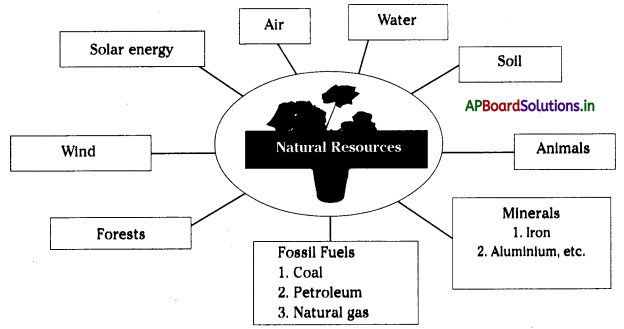Students can go through AP State Board 10th Class Biology Notes Chapter 10 Natural Resources to understand and remember the concept easily.
AP State Board Syllabus 10th Class Biology Notes Chapter 10 Natural Resources
→ The earth’s natural resources are water, soil, minerals, fuels, plants, and animals.
→ Resources that can be replaced after they are used are called renewable resources.
→ Resources that cannot be replaced at all after they are used are called non-renewable resources.
→ Percolation tanks are normally earthen dams with masonry structures where water may overflow.
→ Conservation is the practice of caring for the resources so all living things can benefit from them now and in the future.
→ Management of resources is essential for their conservation and restoration.
→ Resources are usually local specific and local people need to have control over them.
→ People need to be motivated to reduce pressure on the environment by reducing the utilization of resources and reusing some of them.
→ Less than 0.01% of the water on the earth is surface water, but if used judiciously, shall last for a long time.
→ Drip irrigation can reduce water consumption by 70%.
→ Sustainable forestry practices are critical for ensuring resources well into the future.
→ Contour strip cropping helps in reducing soil erosion.
![]()
→ Biodiversity is the variety of living things that populate the earth.
→ We need to protect biodiversity to ensure we have plentiful and varied food sources, medicines, etc.
→ Fossil fuels were produced from the remains of ancient plants and animals.
→ We must use our resources judiciously especially fossil fuels, coal, and petroleum as they will be ultimately exhausted.
→ Scientists are trying to produce renewable biofuels to power cars and trucks.
→ Seeds from the Jatropha curcas plants are used for the production of biofuel.
→ Earth’s supply of raw mineral resources is in danger.
→ Four R’s help to save the environment. They are Reduce, Reuse, Recycle and Recover.
→ Interstate and intercountry disputes should not hamper the availability of a resource.
→ International Union for the Conservation of Nature (IUCN) works to protect wildlife and habitats.
→ Percolation tank: These are the structures for recharging groundwater, normally earthen dams.
→ Micro-irrigation: Irrigating crop fields with less amount of water by drip irrigation and sprinkler irrigation. Water conservation method.
![]()
→ Borewells: A well constructed by boring a vertical hole.
→ Sustainable development: When we use the environment in ways that ensure we have resources for the future it is called sustainable development.
→ Biofuels: A fuel derived from living matter (biological raw materials).
→ Contour strip farming: Forming by planting several crops, such as corn, wheat, and clover, in alternating strips across a slope or across the path of the prevailing wind.
→ Dyke Management: Dykes or barriers, nearly 30 cm thick of brick – cement or stone cement barriers, extending down to the compact bedrock with mud or clay fillings were built in underground streams to tap groundwater optimally.
→ Open dug well: A well made by excavating with hand tools or power machinery Instead of by drilling or driving.
→ Natural resources: Anything In the environment which can be used is called a natural resource.
→ Conservation: The protection of natural things such as animals, plants, forests, etc., to prevent them from being spoiled or destroyed.
→ Renewable resources: Any natural resource that can be replenished or replaced naturally after they are used is called renewable resources.
e.g.: Soil, water, plants, etc.
→ Non-renewable resources: Any natural resource that cannot be replaced at all or takes a long time for their formation are called non-renewable resources. e.g.: Coal, petroleum, natural gas, etc.
→ Selective harvesting: The practice of removing Individual plants or small groups of plants leaving other plants standing to anchor the soil is called selective harvesting.
![]()
→ Biodiversity: The variety of living things that populate the earth.

→ Jean-Baptist Joseph Fourier (1768 – 1830):
- Jean-Baptist Joseph Fourier was a French mathematician and physicist born in Auxerre and best known for initiating the investigation of the Fourier series and their applications to problems of heat transfer and vibrations.
- He was the First one to spoke about the Green House Effect in 1827.
- Gases like Carbon dioxide, Nitrogen oxides, Chlorofluorocarbons, Methane, etc. are called greenhouse gases.
- They warm up the earth and when fossil fuel is burnt Carbon dioxide is released.